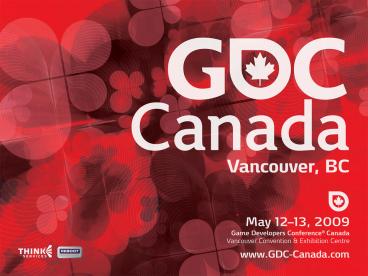Game Object Component Architecture - PowerPoint PPT Presentation
1 / 34
Title:
Game Object Component Architecture
Description:
Helicopter. PhysicsBehaviour. TouchBehaviour. CharacterIntentionBehaviour. MotionTreeBehaviour ... Code that talks to game objects is type-agnostic ... – PowerPoint PPT presentation
Number of Views:40
Avg rating:3.0/5.0
Title: Game Object Component Architecture
1
(No Transcript)
2
Theory and Practice of Game Object Component
Architecture
- Marcin Chady
- Radical Entertainment
3
Outline
- Component-Oriented vs Object-Oriented Programming
- Radicals approach
- Results from PROTOTYPE
4
What are Game Objects?
- Anything that has a representation in the game
world - Characters, props, vehicles, missiles, cameras,
trigger volumes, lights, etc. - Need for a standard ontology
- Clarity
- Uniformity
- Feature, staff and tool mobility
- Code reuse
- Maintenance
- E.g. use of modularity/inheritance reduces
duplication
5
A Game Object Class Hierarchy
GameObject (transform, refcount)
Drawable (renderable model)
Trigger (volume)
Simulated (rigid body model)
Prop
6
Adding Stuff
GameObject (transform, refcount)
Drawable (renderable model)
Trigger (volume)
Simulated (rigid body model)
Animated (animation controller)
?
Animated (animation controller)
7
Mix-ins Perhaps?
GameObject (transform, refcount)
AnimatedMixin (animation controller)
Drawable (renderable model)
Trigger (volume)
Simulated (rigid body model)
Animated
?
AnimatedWithPhysics
8
Observations
- Not every set of relationships can be described
in a directed acyclic graph - Class hierarchies are hard to change
- Functionality drifts upwards
- Specialisations pay the memory cost of the
functionality in siblings and cousins
9
Change
- You can ignore it
- You can resist it
- Or you can embrace it
- But you cannot stop it
10
Component-Based Approach
- Related to, but not the same as aspect-oriented
programming - One class, a container for
- attributes (data)
- behaviours (logic)
- Attributes list of key-value pairs
- Behaviour object with OnUpdate() and
OnMessage()
11
Components vs Hierarchies
GameObject
GameObject
Prop
AttributeltTgt
Behaviour
12
HulkUD Object Model
13
Prototype Game Objects
14
Data-Driven Creation
- Text or binary
- Loaded from pipeline
- Load and go
- Delayed instancing
- Dedicated tools
- Data-driven inheritance
TOD_BeginObject GameObject 1 "hotdog_concession"
behaviours PhysicsBehaviour 1
physicsObject
"hotdog_concession" ,
RenderBehaviour 1
drawableSource "hotdog_concession" ,
HealthBehaviour 1
health 2.000000 ,
GrabbableBehaviour 1
grabbableClass "2hnd"
TOD_EndObject
15
Advantages
- Endowing with new properties is easy
- Creating new types of entities is easy
- Behaviours are portable and reusable
- Code that talks to game objects is type-agnostic
- Everything is packaged and designed to talk to
each other - In short you can write generic code
16
Disadvantages
- In short you have to write generic code
- Game objects are typeless and opaque
- Cant ask, e.g.
- if object has AttachableBehaviour
- then attach to it
- Code has to treat all objects identically
This is wrong!
17
Messaging
- AttachMessage msg(this)
- object-gtOnMessage(msg)
- Dispatched immediately to all interested
behaviours (synchronous operation) - Fast, but not as fast as a function call
- Use for irregular (unscheduled) processing
- Collisions, state transitions, event handling
- Can be used for returning values
18
Attribute Access
- The game object must be notified if you modify an
attribute - Const accessor
- Read-only access
- Cacheable
- Non-const accessor
- Permits writing
- Not cacheable
- Sends a notification message to the game object
- Free access from objects own behaviours
19
An attribute or not an attribute?
- Attribute if
- accessed by more than one behaviour, or
- accessed by external code
- Otherwise a private member of the behaviour
- If not sure, make it an attribute
20
Game Object Update
- GameObjectOnUpdate(pass, delta) for b in
behaviours b.OnUpdate(pass, delta) - OnUpdate() and OnMessage() are the only two entry
points to a behaviour.
21
HealthBehaviour Example
- void HealthBehaviourOnMessage(Message m)
- switch (m.type)
- case APPLY_DAMAGE
- Attributeltfloatgt healthAttr
GetAttribute(HEALTH_KEY) - healthAttr-gtvalue - m.damage
- if (healthAttr-gtvalue lt 0.f)
- mGameObject-gtSetLogicState(DEAD)
- break
- case ATTR_UPDATED
- if (m.key HEALTH_KEY)
- Attributeltfloatgt healthAttr
GetAttribute(HEALTH_KEY) - if (healthAttr-gtvalue lt 0.f)
- mGameObject-gtSetLogicState(DEA
D) - break
22
Components in Practice
- Behaviours and Attributes
- in PROTOTYPE
23
Adoption
- Some coders were resistant
- Too complicated
- Dont know whats going on
- Too cumbersome
- Calling a function is easier than sending a
message - Reading a data member is easier than retrieving
an attribute - Dont like typeless objects
- Ongoing education
24
Post-Mortem Survey
25
Post-Mortem Comments
- Data-driven creation was the biggest win
- Prototyping is the biggest win once you have a
library of behaviours - Modularity of behaviours was the biggest win
- Data inheritance was the biggest win
- Components are nothing new - no modern game could
be built without them
26
Performance
- GameObjectOnUpdate and OnMessage are easy
targets - For the critic
- For the optimiser
- Existing optimisations
- Message masks
- Update masks
- Logic state masks
- Time-slicing
- Attribute caching
- Leaving the back door open
27
Performance Lessons
- Best optimisations are algorithmic
- Avoid unnecessary messages, e.g.
- object-gtOnMessage(message1)
- if (message1.x)
- object-gtOnMessage(message2)
- Prefer attributes over messages
- Avoid unnecessary updates
- Better instrumentation
- Legalise the back door entrance
28
Future Improvements
- Stateless behaviours
- Submit batches of objects to stateless behaviours
- Better suited for parallel architectures
- Message queuing
29
Prototypes Data Types
- 1544 game object definitions
- 145 unique behaviours
- 335 unique data types
- 156 unique prop types alone
30
Behaviour Usage
31
Implicit Class Hierarchy
32
Implicit Class Hierarchy
33
Prop Hierarchy
34
Summary
- Designs change
- Class hierarchies dont like change
- Components do, but not without some sacrifices
35
Questions































